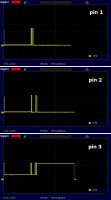WS38 wrote:Physical. A more powerful bulb, consumes more current.Can anyone explain to me in a nutshell what this leaping intensity is all about? What is this phenomenon?

Czy wolisz polską wersję strony elektroda?
Nie, dziękuję Przekieruj mnie tamkwok wrote:The question is whether there is a capacitor in the power supply, because if only the transformer and bridge are connected, after connecting the capacitor, the voltage will increase to over 12V.
WS38 wrote:UNITRA ZATRA power supply model ZS 0.15 / 9/3
220 V; 50 Hz; 5.5 VA
9 V; 150 mA
TechEkspert wrote:The tester is powered by a 9V battery and consumes 12-15mA during measurement, while in sleep mode according to 20nA description (but in practice the current value should be lower, I could not measure the current value in sleep mode).
Janusz_kk wrote:What are you, my misfortune, you hooked this ammeter from the link that you gave or rather the wrong fuse installed in the original place?You forget about the ammeter.
kwok wrote:I haven't read from the beginning.
kwok wrote:If you read, you wouldn't askThe question is whether there is a capacitor in the power supply ...
gumisie wrote:Current jumps when connecting a mini drill and not a light bulb.Physical. A more powerful bulb, consumes more current.
WS38 wrote:The difference in the intensity of about 4%, probably results from the work of the commutator.When the drill was working, the measurements were as follows:
Direct voltage also 9 V.
Leakage current from 96 mA to 101 mA.
vodiczka wrote:Let go (we), further agonizing.gumisie wrote:Current jumps when connecting a mini drill and not a light bulb.Physical. A more powerful bulb, consumes more current.WS38 wrote:The difference in the intensity of about 4%, probably results from the work of the commutator.When the drill was working, the measurements were as follows:
Direct voltage also 9 V.
Leakage current from 96 mA to 101 mA.
TechEkspert wrote:The tester is powered by a 9V battery and consumes 12-15mA during measurement, while in sleep mode according to 20nA description
E8600 wrote:On the contrary. It is reasonable when the tester is used stationary. Why? Because you don't have to worry about the battery falling at the least appropriate moment.Connecting this tester to the power supply is unfounded
E8600 wrote:Connecting this tester to the power supply is unfounded even though I am the enemy of a 9 V battery myself.
The power supply receives equipment mobility.
398216 Usunięty wrote:I confirm I have done so.And nothing stands in the way of connecting the tester's power plug to disconnect the internal battery - you have mobility and no trouble.
E8600 wrote:What is right, but does the tester have to be mobile? Use issue. For example, I use a laptop practically stationary.Connecting this tester to the power supply is unfounded even though I am the enemy of a 9 V battery myself.
The power supply receives equipment mobility.
gumisie wrote:I had my own until I realized that I don't need to use the tester in the field. So I broke the battery (which would not spill or swell) and for several years "flies" on the power supply. Anyway, the same as in # 573 post ...I have done so.
WS38 wrote:Disconnect socket, as follows:What element is best to use here DC socket and plug or a simple slide switch?
398216 Usunięty wrote:There are sockets with a contact opened through the pin of the power supply plug. The most convenient way.
 T4-prob...jpg Download(154.59 kB)
T4-prob...jpg Download(154.59 kB)